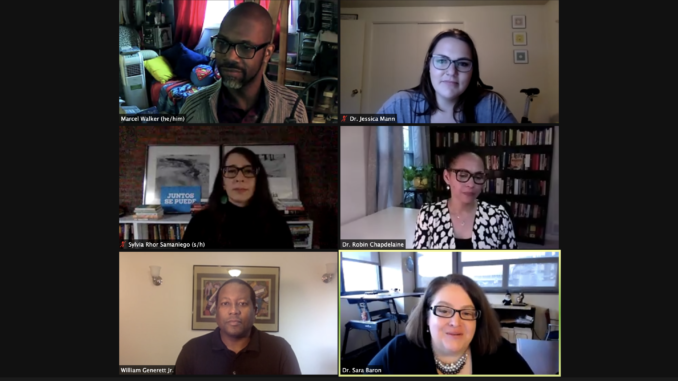
Emily Ambery | Staff Writer
11/12/2020
Heroes in comic books and graphic novels are well-known for fighting monstrous foes, but new heroes are emerging to fight against social injustice. Social justice graphic novels are becoming more of an impactful tool in the classroom.
Duquesne’s Social Justice Reading Club (SJRC) was developed by Gumberg Library faculty in fall 2018 to unite and engage faculty, students and staff in meaningful dialogue around a good book.
The SJRC chooses its reading for each semester based on current social justice issues impacting the world. The SJRC’s book this semester was March: Book One. It is the first volume in a graphic trilogy authored by Lewis, co-writer Andrew Aydin and New York Times best-selling artist Nate Powell.
In the past few years, the club has featured: The Hate You Give by Angie Thomas, Persepolis: The Story of Childhood by Marjane Stratapi, Evicted by Matthew Desmond and The Arrival by Shaun Tan.
The Nov. 5 event was a virtual discussion panel that focused on the life of late Georgia congressman John Lewis. It was co-hosted by Gumberg Library and the Center for Community-Engaged Teaching & Research (CETR).
The panelists for the discussion included Pittsburgh-based artist Marcel Walker; Duquesne history professor Robin Chapdelanie; director of Pitt’s art gallery Sylvia Rhor Samaniego and William Generett Jr., Vice-President of Community Engagement at Duquesne University. The discussion was moderated by assistant vice president of community engagement Jessica Mann.
The event began with presentations from each of the panelists.
First, Rhor Samaniego spoke about her experience meeting Lewis and how the 1957 comic book, Martin Luther King and the Montgomery Story changed Lewis’ life and inspired change for civil rights around the world. With translations of Martin Luther King and the Montgomery Story all over the world, Rhor Samaniego commented that comic books and graphic novels have been and will continue to be a pivotal way to talk about non-violent protests, the civil rights movement and social justice movements.
“It was very compelling to me that a comic book, such as Martin Luther King and the Montgomery Story, had the power to inspire many civil rights activists such as the Greensboro Four and John Lewis,” said freshman secondary education major Natalia Malandro. “The progress the comic book made in American history is amazing.”
Next, Generett Jr. talked about experience working with Lewis as an intern, and continuing to work with him throughout his life. Generett said that Lewis had a profound respect for humanity and his love for spreading awareness about the movement, sharing his perspective and experience to people of all different backgrounds.
“[Lewis’s] role in the Civil Rights movement really helps to relate to kids today with what we see happening with the BLM movement,” said freshman secondary education history major Alex Kurnava. “The ability to connect and remain relevant and inspiring when you’re gone is a special ability that not everyone has in the world.”
Chapdelaine followed by highlighting the critical work of Lewis’ activism and the importance of using comics and graphic novels as a pedagogical tool. She also gave a brief history of graphic novels and their prevalence throughout time. She concluded with her experience of teaching with graphic novels and how the power of image can make a real difference.
“The panel changed my perspective on comic books and graphic novels, I found the educational value behind visuals and illustrations and would like to see more comics and graphic novels implemented in the classroom,” said freshman education major, Luke Kaupinis.
The presentation portion of the event concluded with a presentation from Walker, a Pittsburgh-based artist and board President of the ToonSeum. He shared his experience as a graphic novel writer and artist, and met with Lewis. Walker said that comics can serve as a primer of what we can do and how we should position ourselves morally and ethically.
To end the event, Mann moderated questions between the panelist and questions from the audience for the panel members.
“Not only are comics for superheros, but for stories like March: Book One, where it depicts an actual real life event,” Kurnava said. “I think now more than before that comic books are a legitimate source of not just entertainment but for learning and teaching aspects too.”




